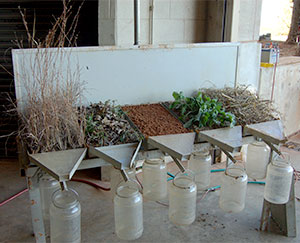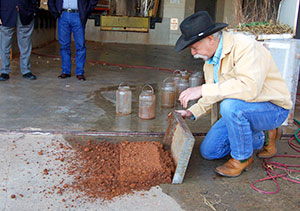Officials Attend Soil Health Talk, Demonstration

Michael Teague, Oklahoma Secretary of Energy & Environment, and State Senators Ron Justice and Clark Jolley attended a rainfall simulator demonstration on November 13, 2013 at the Oklahoma Department of Agriculture, Food, and Forestry (ODAFF). The officials were offered a primer on soil health and water quality in advance of the legislative session, which begins on February 3, 2014. The demonstration was led by Greg Scott, retired Natural Resources Conservation Service (NRCS) State Soil Scientist.
The rainfall simulator is a metal bench with five rectangular pans sitting side-by-side across it. The pans are about the same size and depth as a cake pan, except these have holes punched into the bottoms of them and are filled with soil rather than cake batter. Each pan contains a different soil sample such as traditionally tilled soil, no-till soil (soil that is not tilled), and soil collected in a forest.

Below and in front of each pan hangs a large plastic jar. The jars below are to catch water that penetrates the soil, and the jars in front are to catch water that runs off the surface. To top it all off, a sprinkler is mounted above the display which, when supplied with water, evenly oscillates a spray of water over the soil. The result is a telling picture.
Rainfall Simulator Wows
Scott allowed the simulator to run for about five minutes, simulating a heavy rain storm, during which he placed large clods of traditionally tilled and no-tilled soil into wire mesh bowls suspended in jars of clear water. As he worked, he explained how tillage destroys the roots and fibrous organic matter that naturally holds soil together. This makes the soil vulnerable to erosion by wind and water. When he placed the clods in the water, the tilled soil instantly began to disintegrate and was almost completely gone, floating as fine silt, by the end of the demonstration. The no-till clod, by contrast, held together and showed no measurable loss of soil.

The impact of the dirt clod example was multiplied when Scott stepped back to the rainfall simulator to show the audience the results. For four of the five pans, the water absorption jar was full of water. The one exception was the traditionally tilled sample, of which nearly all of the water had run off—unused by the soil.
“That’s the exact opposite of what my dad taught me,” said Senator Jolley, surprised by the water not soaking into the tilled soil.
Traditional Wisdom Unseated
Traditional wisdom tells us that by tilling up the soil we are preparing it to take in water, but the rainfall simulator and years of research show, within minutes of getting wet, tilled soil forms a crust that is actually water resistant. By contrast, no-till soil is full of decayed root channels and worm tunnels that form aqueducts and cavities that move and hold water. While tilled soil can run off by the ton during heavy rain, no-tilled fields lose very little of their precious, nutrient rich topsoil to wind and rain.

Scott hammered the final nail in the tillage coffin when he removed the pan of traditionally tilled soil and flipped it over on the ground. Despite over five minutes of water pouring over it, the two inches of tilled soil had failed to absorb water. The soil in the bottom of the pan was still dry.
Ideas Discussed
After the demonstration, the group gathered in the ODAFF board room for a question and answer session. Senator Jolley indicated the positive implications widespread no-tilling could have on Oklahoma’s economy, including new industries from more diversified crops, less money spent on water treatment, and sustainable and more productive agriculture. He also noted the challenges the switch could pose, such as a potentially “radical change in rural life.”
Sarah Pope, Oklahoma Association of Conservation Districts (OACD) Programs Director agreed, saying farmers would no longer be corn farmers or cotton farmers. We would “think of that farmer as a soil farmer,” she said, referring to a future when farmers work the rich cultures of bacteria and fungi beneath the surface as much as the crops above.
The conversation turned to Oklahoma’s past conservation missteps, most notably the devastation of the Dust Bowl. The terrible erosion and blinding dust clouds that destroyed crops and homes alike were caused by simple mismanagement of the soil. Pauline Hodges, educator and dust bowl survivor tearfully recounted the words of her father: “The worst thing about the dust bowl is that I helped cause it.” But we didn’t know then what we know now.
